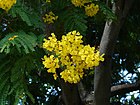Note: This is a project under development. The articles on this wiki are just being initiated and broadly incomplete. You can Help creating new pages.
Difference between revisions of "Peltophorum pterocarpum"
| Line 1: | Line 1: | ||
[[File:Peltophorum pterocarpum (4674430905).jpg |thumb|right|'''Peltophorum pterocarpum''']] | [[File:Peltophorum pterocarpum (4674430905).jpg |thumb|right|'''Peltophorum pterocarpum''']] | ||
| − | '''Peltophorum pterocarpum''' | + | '''Peltophorum pterocarpum''' is a species of Peltophorum. It is native to tropical southeastern Asia and a popular ornamental tree grown around the world. |
==Uses== | ==Uses== | ||
{{Uses|Dysentery}}, {{Uses|Pains}}, {{Uses|Sores}}, {{Uses|Skin disorders}}, {{Uses|Muscular pain}}. | {{Uses|Dysentery}}, {{Uses|Pains}}, {{Uses|Sores}}, {{Uses|Skin disorders}}, {{Uses|Muscular pain}}. | ||
| Line 8: | Line 8: | ||
==Chemical Composition== | ==Chemical Composition== | ||
| − | Chemical constituents such as aliphatic alcohols, fatty acids, amino acids, terpenoids, phenolics, flavonoids, alkaloids, steroids etc. | + | Chemical constituents such as aliphatic alcohols, fatty acids, amino acids, terpenoids, phenolics, flavonoids, alkaloids, steroids etc.<ref name="chemical composition"/> |
| − | <ref name="chemical composition"/> | ||
==Common names== | ==Common names== | ||
| − | {{Common names|kn=|ml=|sa=|ta=|te=|hi= | + | {{Common names|kn=|ml=|sa=|ta=|te=|hi=Peela gulmohar|en=Copperpod, Rusty shield-bearer}} |
==Properties== | ==Properties== | ||
| Line 35: | Line 34: | ||
==Identification== | ==Identification== | ||
===Leaf=== | ===Leaf=== | ||
| − | {{Leaf|Bipinnate| | + | {{Leaf|Bipinnate|Linear in outline|30–60 cm long, with 16–20 pinnae, each pinna with 20–40 oval leaflets 8–25 mm long and 4–10 mm broad.}}<ref name="Leaf"/> |
===Flower=== | ===Flower=== | ||
| Line 41: | Line 40: | ||
===Fruit=== | ===Fruit=== | ||
| − | {{Fruit|Simple Fruit| | + | {{Fruit|Simple Fruit|Ovoid|5–10 cm long and 2.5 cm broad|Red at first, Ripening black|}} |
===Other features=== | ===Other features=== | ||
| Line 52: | Line 51: | ||
==How to plant/cultivate== | ==How to plant/cultivate== | ||
| − | A plant of the moist to wet tropics, where it is usually found at elevations below 100 metres but can occasionally be found up to 1,600 metres. | + | A plant of the moist to wet tropics, where it is usually found at elevations below 100 metres but can occasionally be found up to 1,600 metres.<ref name="How to plant/cultivate"/> |
| − | <ref name="How to plant/cultivate"/> | ||
==Commonly seen growing in areas== | ==Commonly seen growing in areas== | ||
| Line 76: | Line 74: | ||
==External Links== | ==External Links== | ||
| − | * [http://www.theplantlist.org/tpl1.1/record/ild-24832 Peltophorum pterocarpum] | + | * [http://www.theplantlist.org/tpl1.1/record/ild-24832 Peltophorum pterocarpum on the plant list.org] |
[[Category:Herbs]] | [[Category:Herbs]] | ||
[[Category:Fabaceae]] | [[Category:Fabaceae]] | ||
Latest revision as of 16:39, 29 June 2020
Peltophorum pterocarpum is a species of Peltophorum. It is native to tropical southeastern Asia and a popular ornamental tree grown around the world.
Contents
- 1 Uses
- 2 Parts Used
- 3 Chemical Composition
- 4 Common names
- 5 Properties
- 6 Habit
- 7 Identification
- 8 List of Ayurvedic medicine in which the herb is used
- 9 Where to get the saplings
- 10 Mode of Propagation
- 11 How to plant/cultivate
- 12 Commonly seen growing in areas
- 13 Photo Gallery
- 14 References
- 15 External Links
Uses
Dysentery, Pains, Sores, Skin disorders, Muscular pain.
Parts Used
Chemical Composition
Chemical constituents such as aliphatic alcohols, fatty acids, amino acids, terpenoids, phenolics, flavonoids, alkaloids, steroids etc.[1]
Common names
| Language | Common name |
|---|---|
| Kannada | |
| Hindi | Peela gulmohar |
| Malayalam | |
| Tamil | |
| Telugu | |
| Marathi | NA |
| Gujarathi | NA |
| Punjabi | NA |
| Kashmiri | NA |
| Sanskrit | |
| English | Copperpod, Rusty shield-bearer |
Properties
Reference: Dravya - Substance, Rasa - Taste, Guna - Qualities, Veerya - Potency, Vipaka - Post-digesion effect, Karma - Pharmacological activity, Prabhava - Therepeutics.
Dravya
Rasa
Guna
Veerya
Vipaka
Karma
Prabhava
Habit
Identification
Leaf
| Kind | Shape | Feature |
|---|---|---|
| Bipinnate | Linear in outline | 30–60 cm long, with 16–20 pinnae, each pinna with 20–40 oval leaflets 8–25 mm long and 4–10 mm broad. |
Flower
| Type | Size | Color and composition | Stamen | More information |
|---|---|---|---|---|
| Bisexual | Yellow | 2.5–4 cm diameter, produced in large compound raceme up to 20 cm long. Pollens are approximately 50 microns in size. |
Fruit
| Type | Size | Mass | Appearance | Seeds | More information |
|---|---|---|---|---|---|
| Simple Fruit | Ovoid | 5–10 cm long and 2.5 cm broad | Red at first, Ripening black | {{{6}}} |
Other features
List of Ayurvedic medicine in which the herb is used
Where to get the saplings
Mode of Propagation
How to plant/cultivate
A plant of the moist to wet tropics, where it is usually found at elevations below 100 metres but can occasionally be found up to 1,600 metres.[3]
Commonly seen growing in areas
Grassland fields, Teak forests.
Photo Gallery
References
External Links
- Ayurvedic Herbs known to be helpful to treat Dysentery
- Ayurvedic Herbs known to be helpful to treat Pains
- Ayurvedic Herbs known to be helpful to treat Sores
- Ayurvedic Herbs known to be helpful to treat Skin disorders
- Ayurvedic Herbs known to be helpful to treat Muscular pain
- Herbs with Stem used in medicine
- Herbs with Leaves used in medicine
- Herbs with Fruits used in medicine
- Herbs with common name in Hindi
- Herbs with common name in English
- Habit - Tree
- Index of Plants which can be propagated by Seeds
- Herbs that are commonly seen in the region of Grassland fields
- Herbs that are commonly seen in the region of Teak forests
- Herbs
- Fabaceae



